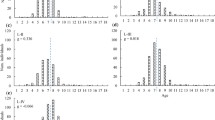Abstract
Germination, establishment and growth of seedlings of tree speciesPalaquium ellipticum (primary),Actinodaphne malabarica (late secondary) andMacaranga peltata (early secondary) were studied in a humid tropical forest at Nelliampathy, in the Western Ghats of Kerala. While the primary species completed its germination within a brief period of 1.5 months, at the other extreme, early secondary species showed slow germination extending for about 5 months, the late secondary species falling in between. Although, all the species studied showed higher establishment and growth under gaps, the early secondary species were more responsive compared to the primary species. Primary species showed better establishment in undisturbed sites and natural gaps than under selection felled gaps; the reverse was true for late and early secondary species. Survival of seedlings increased with gap size, but sharply declined with gap age. Shoot/root ratio was consistently higher in the early secondary species than in the primary species.
Similar content being viewed by others
References
Aiyer B V V 1932 The sholas of the Palghat division: A study in the ecology and silviculture of the tropical rainforests of Western Ghats;Indian For. 58 414–432
Ashton P S 1978 Crown characteristics of tropical trees; inTropical trees as living systems (eds) P B Tomlinson and M H Zimmermann (London: Cambridge University Press) pp 591–615
Balasubramanyan K 1987Impact of selection felling in α forest ecosystem in Kerala (Peechi: Kerala Forest Research Institute)
Baur G N 1964The ecological basis of rain forest management (New South Wales: Forestry Commission)
Bazzaz F A 1990 Regeneration of tropical forests: Physiological responses of pioneer and secondary species; inRain forest regeneration and management (eds) A Gomez-Pompa, B C Whitmore and M Hadley (Paris: UNESCO), MAB series Vol. 6. pp 91–118
Bazzaz F A and Pickett STA 1980 Physiological ecology of tropical succession: a comparative review;Annu. Rev. Ecol. Syst. 11 287–310
Boojh R and Ramakrishnan P S 1982 Growth strategy of trees related to successional status I. Architecture and extension growth;For. Ecol. Manage. 4 359–374
Brokaw N V L 1982 The definition of treefall gap and its effects on measures of forest dynamics;Biotropica 14 158–160
Brokaw N V L 1985 Gap phase regeneration in a tropical forest;Ecology 66 682–687
Chandrashekara U M 1991Studies on the gap phase dynamics of a humid tropical forest, Ph.D. thesis, Jawaharlal Nehru University, New Delhi
Chandrashekara U M 1992 Canopy gap dynamics of a humid tropical in the Western Ghats of Kerala; inProc. 4th Kerala Science Congress (ed.) C G Ramachandran Nair (State Committee on Science, Technology and Environment, Thiruvananthapuram) pp 28–30
Collins B S, Dunne K P and Pickett S T A 1985 Responses of forests herbs to canopy gaps; inThe ecology of natural disturbance and patch dynamics (eds) STA Pickett and P S White (New York: Academic Press) pp 217–234
Denslow J S 1980 Patterns of plant species diversity during succession under different disturbance regimes;Oecologia (Berlin) 46 18–21
Fetcher N, Strain B R and Oberbauer S F 1983 Effects of light regime on the growth, leaf morphology and water relations of seedlings of two species of tropical trees;Oecologia (Berlin) 58 314–319
Hartshorn G S 1978 Tree falls and tropical forest dynamics; inTropical trees as living systems (eds) P B Tomlinson and M H Zimmermann (London: Cambridge University Press) pp 617–638
Hughes A P and Freeman P R 1967 Growth analysis using frequent small harvests;J. Appl. Ecol. 4 553–560
Kadambi K 1941 The evergreen ghat rain forest: Agumbe-Kilandur zone (A study on the tropical rain forest of the western ghats of Mysore);Indian For. 67 184–203
Lugo A 1970 Photosynthetic studies on four species of rain forest seedlings; inA tropical rainforest (eds) H B Odum and R F Pigeon (Tennessee: USAEC, Oak Ridge) pp 181–202
Mackie C, Jessup B C, Vayda A P and Kartawinata K 1986 Shifting cultivation and patch dynamics in Anupland forest in East Kalimantan, Indonesia; inRegional workshop on impact of mans activities on upland forest ecosystems (Serdeng, Malaysia) (Mimeo)
Oberbauer S A, Clark D B and Quesada M 1988 Crown light environments of saplings of two species of rain forest emergent trees;Oecologia (Berlin) 75 207–212
Okali D U U 1972 Growth-rates of some West African forest tree seedlings in shade;Ann. Bot. 36 953–959
Popma J and Bongers F 1988 The effect of canopy gaps on growth and morphology of seedlings on rainforest species;Oecologia (Berlin) 75 625–638
Radford P J 1967 Growth analysis formulae — their use and abuse;Crop Sci. 7 171–175
Ramakrishnan P S, Shukla R P and Boojh R 1982 Growth strategies of trees and their application to forest management;Curr. Sci. 51 448–455
Richards P W 1952The tropical rainforest (London: Cambridge University Press)
Shukla R P and Ramakrishnan P S 1982 Comparative study on field germination and establishment of early vs late successional trees in Northeastern India;Proc. Indian Natl. Sci. Acad. B48 115–120
Snedecor G W and Cochran W G 1967Statistical methods (New Delhi: Oxford and IBH)
Swaine M D and Whitmore B C 1988 On the definition of ecological species groups in tropical rain forests;Vegetatio 75 81–86
Whitmore B C 1984Tropical rainforests of the Far East (Oxford: Clarendon Press)
Whitmore B C and Bowen M R 1983 Growth analysis of someAgathis species;Malay. For. 46 186–196
Author information
Authors and Affiliations
Rights and permissions
About this article
Cite this article
Chandrashekara, U.M., Ramakrishnan, P.S. Gap phase regeneration of tree species of differing successional status in a humid tropical forest of Kerala, India. J Biosci 18, 279–290 (1993). https://doi.org/10.1007/BF02703125
Received:
Revised:
Issue Date:
DOI: https://doi.org/10.1007/BF02703125




